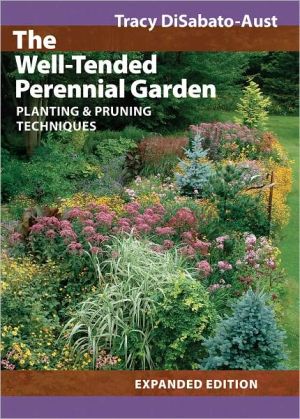The Well-Tended Perennial Garden: Planting & Pruning Techniques
With more than 130,000 copies sold since its original publication, The Well-Tended Perennial Garden has proven itself to be one of the most useful tools a gardener can have. Now, in this expanded edition, there's even more to learn from and enjoy. This is the first, and still the most thorough, book to detail essential practices of perennial care such as deadheading, pinching, cutting back, thinning, disbudding, and deadleafing, all of which are thoroughly explained and illustrated. More...
Search in google:
With more than 130,000 copies sold since its original publication, The Well-Tended Perennial Garden has proven itself to be one of the most useful tools a gardener can have. Now, this new, expanded edition promises to be an even more effective ally in your quest to create a beautiful, healthy, well-maintained perennial garden. Publishers Weekly To pinch or not to pinch is not the only question addressed here. Horticulturist DiSabato-Aust affirms that pinching is essential for plant robustness and an extended blooming season. In addition to explaining how and where to pinch a plant, she details correct techniques for deadheading, effectively removing the mystery from perennial pruning by referring to it "as grooming, shaping, shearing or snipping." Recognizing the diverse styles of gardens and gardeners, she demonstrates how different approaches to pruning can produce varied growth and blooming patterns. Also offered is information on site selection, soil preparation, planting and disease and pest control. Most impressive is the extensive encyclopedia of perennials which, drawing principally on her own field experience, focuses on pruning and maintenance practices. Practical appendices include a month-by-month calendar of pruning and maintenance tasks and a list of perennials arranged in 35 categories related to their specific pruning and maintenance requirements. Beth Ann Daye's line drawings and the author's color photos enhance the clarity of the text and make this book invaluable for both home gardeners and professionals. (Mar.)
\ Deadheading\ "Don't Be a Deadhead" is the title of one of my more popular lectures about pruning perennials and preparing planting beds. When I was preparing this talk for a mixed audience of both professionals and homeowners I asked my husband to listen to it and give me his opinion, representing the very novice gardener. In his usual, patient way he waited until I was completely finished with the one-hour discussion, and then said, "you better tell them what a deadhead is."\ Fortunately no one left the room during my first talk when they found out that I was discussing the removal of old or spent dead flowers and not old or spent rock 'n' rollers (although the latter does sound somewhat more intriguing). I have been called the "deadhead queen" by various colleagues because of my work with pruning — I'm not sure if there is any deeper meaning to this ...\ Deadheading is beneficial to most herbaceous ornamental plants. Usually there is deadheading to be done from spring to killing frost. You'll enjoy the process more and are less likely to feel overwhelmed if you keep up with it. There are many reasons for deadheading. Primarily, deadheading can prolong the bloom period for plants on which the flowers open over a period of several weeks, or it can initiate a second flush of smaller, sometimes shorter and less numerous blooms on plants that have a single heavy bloom (see Appendix C, lists 14 and 15). It can improve the overall appearance of the plant, giving a fresh new look to an otherwise finished or even distracting item (see Appendix C, list 16). It can persuade biennials to behave like perennials. It can prevent self-seeding. I also like to remove deadheads or seed-heads that weigh down the plant's foliage. Seed production can drain a plant's energy, and consequently, with certain perennials it can cause the foliage to deteriorate. Deadheading can promote vegetative and root growth rather than seed production and help retain the plant's healthy appearance.\ The age of a plant greatly influences its deadheading needs. New plants give the gardener a grace period by requiring less frequent deadheading in their first year in the garden. The honeymoon, so to speak, is over after that first year, however, as deadheading hits full force the second season. Weather also greatly affects deadheading from season to season, with cool, moist weather extending the bloom life and sweltering heat and pelting rain decreasing it.\ Basic Deadheading Methods\ How to deadhead depends on the particular growth habit of the plant. The most common question I hear from people is "how far down do I prune?" Sometimes you need to remove individual dead flowers one at a time, or remove whole clusters of dead flowers, or cut off the entire flowering stalk or scape. Due to the fact that deadheading, as with other forms of pruning, is so species-specific, it is diffcult to categorize or group plants into neat compartments. A key thing to look for when deadheading is the presence of new buds or new flowers. If they are present, deadhead to the new buds or flowers. In Appendix C, lists 17 and 18, I indicate those perennials that should be deadheaded to a lateral flower, bud, or leaf and those that should be deadheaded to the ground or to basal foliage. These lists are intended as general guidelines only, and a few of the plants could be in either list; consult the encyclopedia for individual plant requirements. A review of some basic botany in the drawing below may be helpful at this point.\ Questions often arise about when to deadhead a plant that has a flower spike on which the flowers at the bottom of the spike open first, in which case the flowers at the bottom start to develop into seed while the flowers near the tip of the spike are still opening. (This flowering pattern is technically termed indeterminate.) If let go too long, often such a plant will produce rather long and gangly looking flower spikes, full of seed capsules and with two or so little flowers overwhelmed at the tip. This may be a personal preference, but it is best to not let things go this long. A general rule-of-thumb would be to deadhead when the seedpods outnumber the flowers or when the spike is about 70% finished with flowering.\ Deadhead to a lateral flower, bud, or leaf\ The majority of perennials require deadheading to a lateral flower, bud, or leaf. Plants of this type include popular perennials like shasta daisies, yarrow, salvia, and veronica (see Appendix C, list 17). Many of these perennials also require further cutting down to basal foliage after all flowering is finished (see Chapter 10, and Appendix C, list 27, for more information). To deadhead, prune off the dead flower stem to a new lateral flower or, if visible, to a lateral bud; if neither are apparent, cut the old flower off at the first lateral leaf.\ Many perennials can also be deadheaded by shearing, thus eliminating the tedious task of deadheading each individual old flower above a lateral leaf. Chapter 10 provides more information and illustrations on using this method. Also refer to Section Three for plants suitable for shearing.\ Plants like balloon flower (Platycodon grandiflorus) and peachleaf bellflower (Campanula persicifolia) require careful deadheading of each individual flower along the stem. New buds are produced adjacent to the old flowers along the stem, and if the stem is cut back to the foliage before this flowering is completed, the bloom period will be greatly shortened.\ Perennials such as Aquilegia, Gypsophila paniculata, Hemerocallis, and Scabiosa columbaria 'Butterfly Blue', which have branching flowering stems, also require careful attention to detail when being deadheaded. Deadheading for these plants involves cutting the old flower and its stem down to a lateral flowering stem or bud; then, when this next lateral stem or bud is done flowering, it is cut down to another lateral flowering stem, if present, or, if not, to the basal foliage. With daylilies (Hemerocallis), the individual deadheads — which become wet, slimy, mummy-shaped dead flowers or, as I like to call them, "mush-mummies" — first should be pruned or snapped off using your fingers, taking care not to damage any of the new buds. When no more new buds are visible in the bud cluster, the entire flowering stem should be cut off at the base (see the Encyclopedia of Plants for more details).\ Deadhead to the ground\ Perennials with a single bare flower stem (sometimes with a few small insignificant leaves on the stem) should have their stem cut off close to the ground at the base of the plant when all flowering is finished. Heuchera, Hosta, and Kniphofia are examples of plants with this type of flowering (see Appendix C, list 18).\ The renowned author, lecturer, and perennial gardener Elsa Bakalar taught me that some plants, like lady's mantle (Alchemilla mollis) and certain geraniums, which would normally be deadheaded to the ground or to basal foliage, can also be deadheaded by pulling the old flowering stems out of the plant, right to the root. This way, these otherwise wide-growing plants can be kept in bounds and even thinned in the process. Pulled stems often have roots on them that will take if replanted.\ To Seed, Or Not To Seed ...\ The question of whether or not you should deadhead to prevent self-seeding depends primarily on your objectives for the garden and how you want to spend your time: deadheading or removing seedlings. (See Appendix C, list 19, for plants that reseed.) The weather can influence deadheading needs because it affects the amount of reseeding that occurs; wet springs, for example, can greatly enhance germination. Another consideration is whether the seeds will develop into the desirable plant. Species forms will grow true to type from seed, but cultivars may not and so allowing them to go to seed can be a pitfall. Sometimes this provides the gardener with pleasant surprises, but usually they are not so pleasant — these unpleasant progeny can take over the desirable cultivar, leaving you wondering what you started with. This is often the case with Phlox paniculata.\ Personally, I like some seeding in my gardens to promote that "unplanned" look. This approach can be promoted a bit too much, and I pay the price by spending a great deal of time removing unwanted plants. On the other hand, perennials such as columbine (Aquilegia) and rose campion (Lychnis coronaria) are rather short lived and readily perpetuate themselves if allowed to self-sow. Biennials such as sweet william (Dianthus barbatus), as well as some of my favorite annuals like Brazilian verbena (Verbena bonariensis) and nigella or love-in-a-mist (Nigella damascena), I treat as perennials because they self-sow reliably. The nigella stay close by the feet of their original parents. This is a point that also comes into play when deciding whether to allow plants to seed: do the seeds fall close to the parent — which won't mean too much work — or do they scatter everywhere — which can result in a great deal of work? You can be selective with your deadheading, particularly with prolific seeders, and remove all but a few deadheads to allow smaller numbers of seedlings in. This is a good approach but takes some forethought. If seeding is desired but the deadhead is unattractive, as in the case of a spiked flower like Digitalis, the spike can be shortened, thus still allowing for some seeding but without being so obtrusive. In some years you may not need any new seedlings, in which case the plants should be completely deadheaded. A predominately self-sown garden can be an economical approach for the budget-conscious gardener, although it does require intervention to keep it managed.\ So, in certain instances, reseeding can actually be a reason for not deadheading, such as when it makes for a more diverse or more economical planting. Attractive seedheads is another big reason. Many plants, such as Anemone pulsatilla, Asclepias tuberosa, Dictamnus albus, Sedum 'Autumn Joy', and most of the ornamental grasses, extend their season of interest through the summer to the fall, perhaps even into winter, with their ornamental deadheads (see Appendix C, list 20). Care must be taken, however, to not allow too much seed formation; even if you choose to allow seedheads to form because they are attractive, physiological concerns for the plant remain. The seeds are a sink for the plant's energy and the rest of the plant may suffer. I found this to be true with Siberian iris. I got greedy one year and left all the deadheads on the plants until the following spring, at which time I cut them and used them for dried arrangements. The plants were drastically weakened, opened up in the center, and had a significant reduction in the number of flowers produced — all the signs that division is needed. The plants were only 2 years old, and Siberian iris usually doesn't require frequent division, so I figured that this condition was related to the number of seedheads allowed to mature. Now I remove about two-thirds of the seedheads and allow one-third to mature on the plants. This doesn't seem to drain them.\ Some plants are just so willing to please that they offer us rebloom as well as pretty seedheads. In certain cases you can have both at the same time if you deadhead a few flowering stems and leave others to ripen. In most cases, though, you will need to deadhead the entire plant, let it rebloom, and allow this secondary display to ripen for your ornamental seedheads.\ Some perennials have unattractive deadheads that require frequent (daily is best) deadheading to look decent. Most modern daylilies (Hemerocallis), Coreopsis lanceolata, Hibiscus moscheutos, and Leucanthemum ×superbum, to name a few, fall into this category. Plants of this nature are not good choices for the low-maintenance gardener. Older daylilies with smaller flowers, such as Hemerocallis 'Mme. Bellum', are exceptions, as they drop their old flowers cleanly.\ Perennials such as Gaura, Linum, and Tradescantia (whose flowers actually melt away) shed their petals discreetly, but they usually do this by the afternoon, thus leaving the evening devoid of their beauty — a let-down for the gardener who is away all day and can only enjoy the garden in the evenings after returning home. Other self-suffcient "petal droppers," including Belamcanda, Coreopsis verticillata, and Lychnis coronaria, hold their flowers for longer than one day (see Appendix C, list 21). It should be noted that although these plants neatly dispose of their dead flowers, they still are producing seedheads that produce seed, and so they may require deadheading either to prevent seeding or to help produce or prolong bloom. But at least they don't require daily attention like some of the others.\ Astilbe, Baptisia, Papaver orientale, and others do not flower longer or repeat their bloom if deadheaded, so this extra work is not needed. It can also be beneficial to not deadhead perennials that flower late in the season, such as Boltonia or Chrysopsis, as their entire structure, including seedheads, can be left for winter interest. Perennials such as these that do not require deadheading are listed in Appendix C, list 22. This list also includes plants that normally do not reseed or they may have attractive seedheads, so if they are not deadheaded it isn't a problem.\ Certain silver-leaved perennials, such as the artemisias, Santolina chamaecyparissus, and Stachys byzantina, have foliage that will deteriorate if the plants are allowed to go to seed. Deadheading allows the plant's energies to stay directed toward foliage production. These plants often are not blessed with particularly outstanding flowers anyway, and usually I remove the flower buds before they even open, keeping the plant in a strictly vegetative state.\ Birds are another element to consider when deciding whether or not you are going to deadhead your perennials. Genera such as Echinacea, Heliopsis, and Rudbeckia are attractive to gold finches, and I have had flocks of gold finches in my gardens munching on these plants. Echinacea is a partcularly favorite delicacy for the finches as well as for the juncos over the winter. The only problem is that Echinacea will seed in outrageous proportions all over the garden. I tried hanging bundles of cut stems from a tree, but the finches didn't seem to be as attracted to these as to the ones in the gardens, so I always leave a few drifts up for them in various spots. Hosta seeds are savored by chickadees. Watching the birds in the gardens in the summer and winter adds a special dimension to perennial gardening.
Ch. 1Design and its relationship to maintenance16Ch. 2Bed preparation : insurance for success31Ch. 3Planting and establishment53Ch. 4Pests and diseases of perennials69Ch. 5Staking81Ch. 6Division85Ch. 7Renovation of the established perennial garden89Ch. 8Introduction to pruning98Ch. 9Deadheading110Ch. 10Cutting back121Ch. 11Pinching, disbudding, thinning, and deadleafing138Ch. 12Purning to prepare for winter and pruning to prepare for spring147Guide to using the encyclopedia158A-Z encyclopedia of perennials160Perennial maintenance journal313App. AOrnamental grasses343App. BPerennial garden planting and maintenance schedule347App. CList of perennials for specific pruning and maintenance requirements353
\ Buffalo News“The must-have book on perennial care, species-by-species.”\ \ \ \ \ New York Times"The plant expert Tracy DiSabato-Aust says that slightly tender plants, like certain asters, chrysanthemums and ferns, benefit from the layer of protection their dead tops offer during the winter. And their seeds are also beneficial to the birds."\ \ \ St. Paul Pioneer Press"This book raise[s] gardeners' awareness through its refusal to pull punches or let the central tenets get lost in thickets of flowery prose. It's probably the most down-and-dirty book on gardening I've ever read."\ \ \ \ \ \ \ \ Detroit News"[This book] is number one on my list of must-read gardening books because it takes the mystery out of how to become a first-class perennial gardener."\ \ \ \ \ Cleveland Plain Dealer"Well worth revisiting, with more than 200 new photos and a 32-page journal section in which you can enter details, notes, and observations about the requirements and performances of perennials in your own garden." \ — Suzanne Hively\ \ \ \ \ Seattle Times"A practical book filled with the details of how to care for perennials..." \ — Valerie Easton\ \ \ \ \ Horticulture"If you don't have a horticulture background, are too busy to take the master gardener program, and wonder about the nuts and bolts of gardening, read this book." \ — Steve Aitkin\ \ \ \ \ Publishers WeeklyTo pinch or not to pinch is not the only question addressed here. Horticulturist DiSabato-Aust affirms that pinching is essential for plant robustness and an extended blooming season. In addition to explaining how and where to pinch a plant, she details correct techniques for deadheading, effectively removing the mystery from perennial pruning by referring to it "as grooming, shaping, shearing or snipping." Recognizing the diverse styles of gardens and gardeners, she demonstrates how different approaches to pruning can produce varied growth and blooming patterns. Also offered is information on site selection, soil preparation, planting and disease and pest control. Most impressive is the extensive encyclopedia of perennials which, drawing principally on her own field experience, focuses on pruning and maintenance practices. Practical appendices include a month-by-month calendar of pruning and maintenance tasks and a list of perennials arranged in 35 categories related to their specific pruning and maintenance requirements. Beth Ann Daye's line drawings and the author's color photos enhance the clarity of the text and make this book invaluable for both home gardeners and professionals. (Mar.)\ \ \ \ \ Library JournalGet two copies, one for reference and one for circulation. The last two-thirds is an A-Z Encyclopedia of Perennials with exceptional details on the pruning and maintenance of perennials. Copyright 1999 Cahners Business Information.\ \ \ \ \ BooknewsDescribes the maintenance and long-term care of herbaceous perennial plants. Offers guidelines for the various stages of creating a perennial border or bed, and specific pruning techniques for deadheading, cutting back, pinching, disbudding, thinning, deadleafing, and preparing for winter and spring. An Encyclopedia of Perennials includes information on climate zones, size, exposure, time of flowering, related plants, and techniques for pruning and maintenance. Includes 131 color photos. No subject index. Annotation c. by Book News, Inc., Portland, Or.\ \







